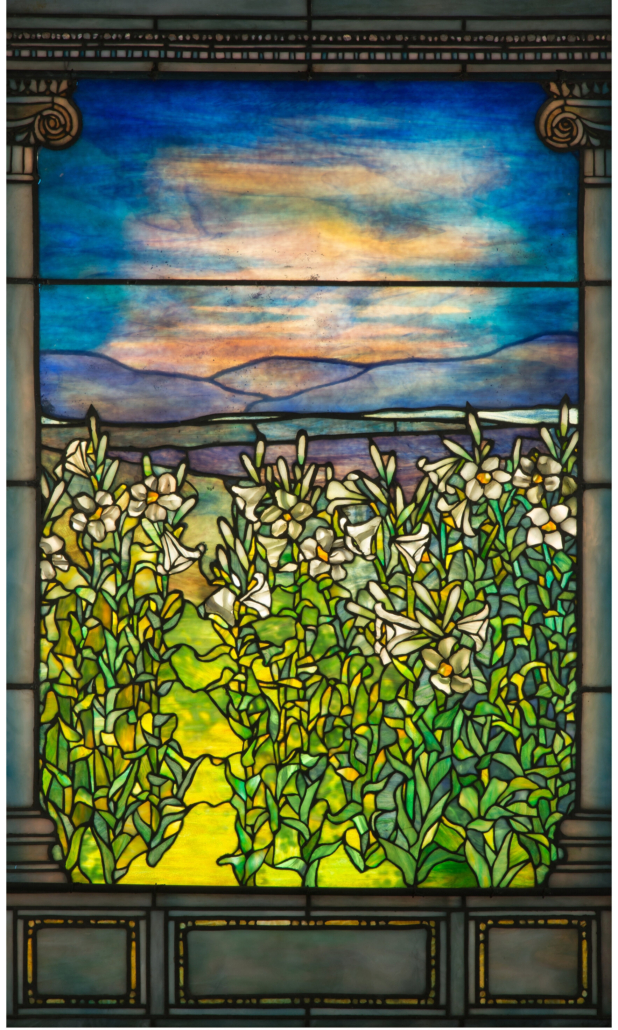
Tiffany Studios leaded glass Lily window, which could command $100,000-$150,000
DALLAS, Texas – Louis Comfort Tiffany, heir to Tiffany & Co. and founder of Tiffany Studios, revolutionized the manufacture of leaded glass through technical advancement and a new aesthetic sensibility. The Tiffany Studios leaded glass Lily window, among the top attractions offered in Heritage Auctions’ Tiffany, Lalique & Art Glass Including Art Deco & Art Nouveau Auction on April 29, demonstrates Tiffany Studios’ technical and artistic prowess at the height of its production and influence. Dated circa 1900 and measuring 52 1/2 inches high by 32 1/4 inches wide, the Lily window carries a pre-auction estimate of $100,000-150,000. Absentee and Internet live bidding will be available through LiveAuctioneers.
“Authentic Tiffany Studios windows are coveted pieces. Those without overt religious iconography are exceptionally rare, and don’t appear at auction frequently,” said Nick Dawes, Senior Vice President of Special Collections at Heritage Auctions. “Given the subject matter and considerable scale of this window, it would be an ideal fit for a private or museum collection.”
The son of Tiffany & Co. founder Charles Lewis Tiffany, Louis Comfort Tiffany began his career as a painter, traveling extensively throughout Europe, North America and even North Africa painting landscapes, genre scenes and portraits. By the mid-1870s, the younger Tiffany turned to glass in response to the Arts and Crafts movement, which endeavored to dissolve the boundary between the fine and applied arts; the Aesthetic Movement, which advocated for “art for art’s sake;” and the powerful religious zeal then sweeping the United States.

Detail of the Tiffany Studios leaded glass Lily window, which dates to circa 1900
After several stints at Brooklyn glass studios, he founded Louis Comfort Tiffany and Associated American Artists in 1879 and later a series of firms – all bearing the Tiffany name – that concentrated first on glass and later delved into virtually every medium: leaded glass windows and lamps, glass objects, ceramics, mosaics, enamels, metalwares, and jewelry. By late 1892 or early 1893, Tiffany had built his own glasshouse in Corona, Queens, where he and British-born glazier Arthur Nash experimented with glass ultimately branded Favrile, based on the Old English word fabrile, meaning “handwrought.” Favrile glass in a variety of types – opalescent, drapery, mottled, streamer, confetti, and more – adorned Tiffany Studios leaded windows and lamps through 1932, when Tiffany Studios ceased operations.
While the original site of installation is unknown, the Lily window’s prominent use of white Easter lilies indicates that it may have been produced, more than a century ago, as a memorial. The foreground is dominated by a field of lilies, with verdant stems and leaves and blooms viewed from several perspectives and rendered in milky opalescent glass, including more than two dozen pieces of drapery glass that lend three-dimensionality. Beyond the field lies an undulating horizon below a vast sky marbled with bright blue and pale pink and yellow. Plating, a technique of layering multiple pieces of glass, was used to execute the series of hills that recede into the distance, thereby achieving depth of field. The entire scene is framed by an opalescent glass architectural structure. It features a decorative frieze with a band of jeweled glass above dentil molding achieved through alternating opalescent and blue glass pieces. The frieze is held aloft by a pair of Ionic columns atop a foundation accented by blocks outlined in ripple glass.

Another view of the Tiffany leaded glass Lily window, which measures more than four feet high
A compositional parallel can be drawn between the Lily window and the larger and more complex Field of Lilies window designed by Tiffany for the chapel at the World’s Columbian Exposition in Chicago in 1893, which was later installed in Laurelton Hall circa 1916 and is now held in the permanent collection of the Morse Museum in Winter Park, Florida.
The winning bidder will receive a prize ready for display; the window is offered along with a custom frame with light box and pedestal.
[av_button label=’ Click to view the auction catalog and sign up to bid’ icon_select=’no’ icon=’ue800′ font=’entypo-fontello’ link=’manually,https://www.liveauctioneers.com/catalog/199562_tiffany-lalique-and-art-glass-dallas-8040/’ link_target=’_blank’ size=’small’ position=’center’ label_display=” title_attr=” color_options=” color=’theme-color’ custom_bg=’#444444′ custom_font=’#ffffff’ btn_color_bg=’theme-color’ btn_custom_bg=’#444444′ btn_color_bg_hover=’theme-color-highlight’ btn_custom_bg_hover=’#444444′ btn_color_font=’theme-color’ btn_custom_font=’#ffffff’ id=” custom_class=” av_uid=’av-7d4it5r’ admin_preview_bg=”]
View top auction results on LiveAuctioneers here: https://www.liveauctioneers.com/pages/recent-auction-sales/



